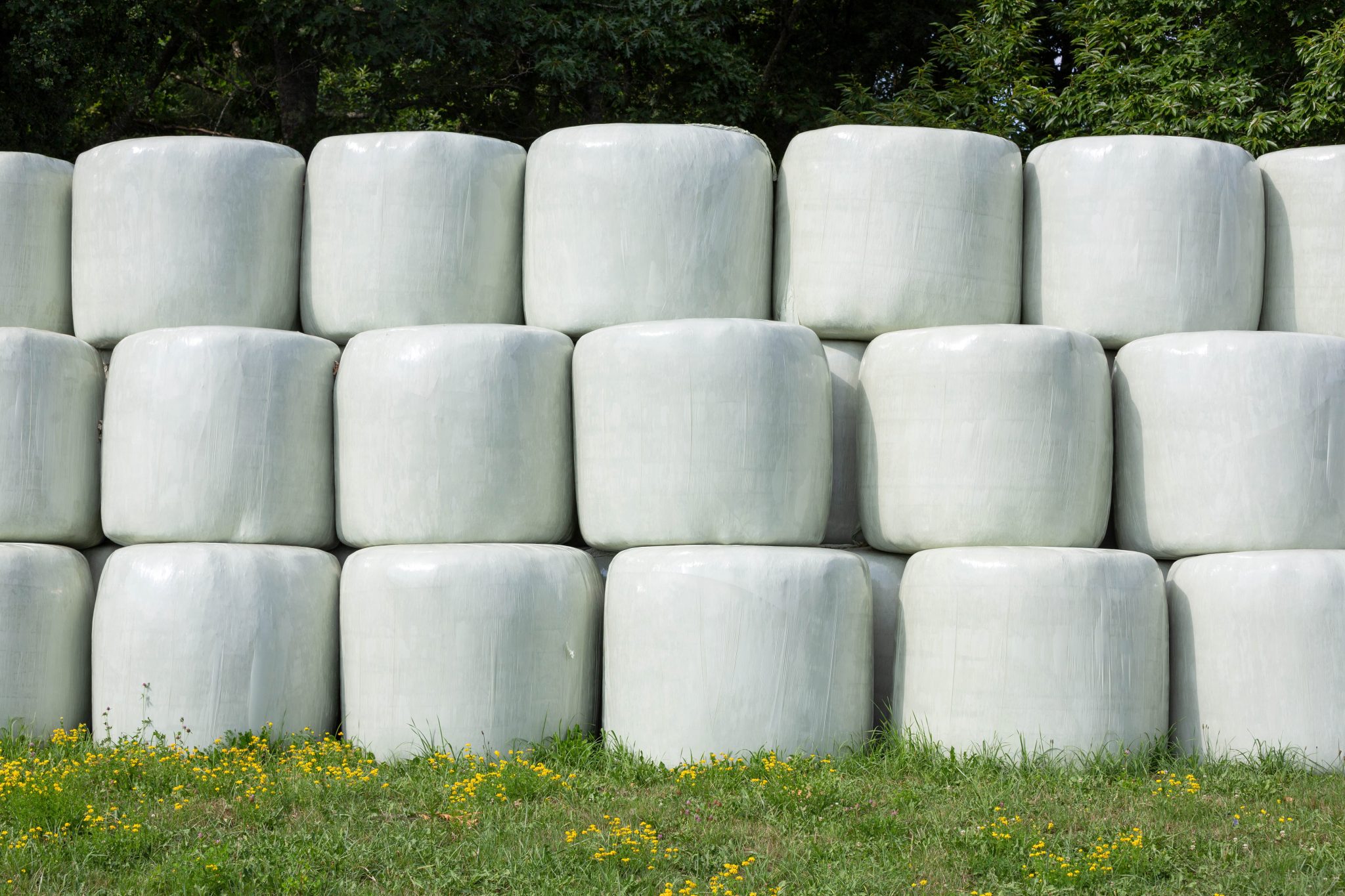Beef

Haylage and baleage are terms often used interchangeably. Haylage is harvested forage ensiled at 40 to 60 percent moisture. Dry hay, haylage, and silage are all methods of producing stored forage reserves, but each differ in their percent moisture (Table 1). Baleage is a form of haylage that has been harvested, baled, and wrapped.
Table 1. Average Percentage Moisture of Stored Forages
| Stored Forage Type | Moisture, % |
|---|---|
| Dry hay | ≤ 20% |
| Haylage | 40–60% |
| Silage | ≥ 65% |
Considerations for Feeding Baleage to Beef Cattle
Match
The decision to feed baleage starts with matching forage quality with the nutrient requirements of the class of livestock being fed. Information on the nutrient requirements of beef cattle can be found in Extension publication ANR-0060, “Nutrient Requirements of Beef Cattle.” Baleage is a stored feed that should address a time of supplemental nutrient demand in your beef cattle herd. It is important to consider if making baleage can reduce the need for supplemental feeds by harvesting and storing high-quality forage. For example, research has shown that annual ryegrass baleage harvested at the boot stage ranges from 60 to 65 percent total digestible nutrients (TDN) and 10 to 16 percent crude protein (CP).
This high-value forage can be readily used to meet the nutrient requirements in most cow-calf operations. A forage test is needed to accurately determine the nutritional value of baleage and if additional supplementation is needed outside this feedstuff. Without knowing the quality of the forage being fed, it is impossible to know if it is meeting the animal’s daily nutrient requirements.
Quality Matters
The stage of plant maturity at harvest is the single largest factor affecting the feeding value of baleage. The nutritional quality of baleage will only be as good as the starting product. What goes in must come out, and putting up low-quality forage means a low-quality feed product. The process of putting up baleage can also impact feeding value. Bales that are wrapped with a minimum of six layers of plastic between a moisture range of 40 and 60 percent can decrease storage loss and produce a more stable product at the time of feeding.
Quantity Matters
Understanding how much forage or feed cattle consume per day is one of the most important criteria for developing a good nutrition program. This requirement is based on daily dry matter intake, or the amount of forage and feed consumed per day without moisture (100 – % moisture = % dry matter). Many factors affect dry matter (DM) intake including animal weight, stage of production, forage quality, and environmental conditions. A good rule of thumb is that a mature cow will consume about 2.5 percent of her body weight per day in dry matter. If high moisture forage is the sole source of dry matter in the diet, it will take more baleage by weight than dry hay to feed the same class of animals. Below is an example of the amount of hay versus baleage needed to feed a 1,200-pound brood cow.
Additives
Commercial additives such as enzymes and inoculants are available to help with preservation of stored high- moisture forages. Additives can improve the feeding value by increasing preservation of dry matter, decreasing heating and molding during storage, and helping preserve forage during feed out. However, they do not add additional pounds of TDN or CP and cannot be used to mask the effects of putting up overmature forage. Remember the quality of baleage will only be as good as the starting product. Additives mainly work to rapidly drop the pH within the bale, which promotes fermentation and preservation of the dry matter and nutrients present.
Spoilage
Spoilage can occur from microbial growth during fermentation. Microbes that survive without oxygen, such as Listeria monocytogenes and Clostridium botulinum, can pose serious, life-threatening risks to cattle. These bacteria can cause spoilage under conditions of high moisture (≥ 65 percent), soil/manure contamination, improper sealing, and high pH. Key signs of spoilage include a dark brown/black bale color, wet, slimy feel, rancid smell, and poor palatability to the animal.
Clinical signs of botulism include brain inflammation, disorientation, impaired nervous system function, and continuous salivation. Contact a veterinarian immediately if these signs are observed. Some mold on the surface of bales is often seen. White, pink, gray, and blue molds may be visible, but have not been shown to cause problems when feeding. However, excessive amounts of mold should be avoided. Tightly wrapping bales will help decrease the amount of mold occurrence.
Feeding Strategies
Baleage can be fed as whole bales or chopped/ground for incorporation into mixed rations. As with any new feed source, understand that it may take an adjustment period for animals to become accustomed to baleage, particuarly with young, growing animals. Feeding losses can be minimized using an improved feeding technique such as a cone- or ring-type feeder, trailer, or cradle. Provide an amount that allows animals to consume bales within 1 to 2 days to prevent spoilage. When feeding baleage during the summer months, allocate only enough for 1 day.

Feeding Hay (85% DM, 15% moisture) to 1,200-lb brood cow
- 2.5% body weight = 30 lb DM
- Amount to feed = 30 lb DM/85% DM
- X = 35 lb hay needed per day
Feeding Baleage (50% DM, 50% moisture) to 1,200-lb brood cow
- 2.5% body weight = 30 lb DM
- Amount to feed = 30 lb DM/50% DM
- X = 60 lb baleage needed per day
Download a PDF of Strategies for Using Baleage in Beef Cattle Operations, ANR-2218.

